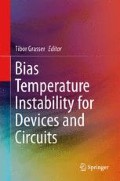Abstract
This chapter describes the use of random telegraph noise (RTN) to obtain information about traps in highly scaled MOSFETs. A robust hidden Markov model (HMM) algorithm is presented to enable the accurate extraction of trap parameters from both single and multiple-trap signals. The results of a large number of measurements show that even in the absence of bias stress, RTN-generating traps can cause serious variation for high-k/metal gate (HKMG) FETs and that undoped channels do not reduce the problem. Trap time constants are shown to have wide ranging dependence on bias and temperature, leading to hysteretic behavior with time constants much longer than the circuit timescale. The impact of RTN on the stability of memory cells is also presented, along with experimental observations of these effects in SRAM arrays.
Access this chapter
Tax calculation will be finalised at checkout
Purchases are for personal use only
Notes
- 1.
To be precise, this description corresponds to an acceptor-type trap, but we prefer not to focus on the trap types because some traps defy easy categorization. Instead, we simply use the preceding definitions of “capture” and “emission” for all traps when plotting |I D | versus time.
- 2.
Some trap models involve three or four internal states but only two observable charge states. Those models can readily be incorporated into this framework, but are not explicitly considered here.
References
K. S. Ralls, W. J. Skocpol, L. D. Jackel, R. E. Howard, L. A. Fetter, R. W. Epworth, and D. M. Tennant, Phys. Rev. Lett. 52, 228 (1984).
N. Tega, H. Miki, Z. Ren, C. P. D’Emic, Y. Zhu, D. J. Frank, J. Cai, M. A. Guillorn, D.-G. Park, W. Haensch, and K. Torii, in 2009 IEDM Tech. Dig., (IEEE), p. 771.
K. Takeuchi, IEICE Trans. Electron. E95-C, 414 (2012).
H. Miki, N. Tega, M. Yamaoka, D. J. Frank, A. Bansal, M. Kobayashi, K. Cheng, C. P. D’Emic, Z. Ren, S. Wu, J-B. Yau, Y. Zhu, M. A. Guillorn, D.-G. Park, W. Haensch, E. Leobandung, and K. Torii, in 2012 IEDM Tech. Dig., (IEEE), p. 450.
T. Grasser, H. Reisinger, W. Goes, T. Aichinger, P. Hehenberger, P.-J. Wagner, M. Nelhiebel, J. Franco, and B. Kaczer, in 2009 IEDM Tech. Dig., (IEEE), p. 729.
H. Miki, M. Yamaoka, N. Tega, Z. Ren, M. Kobayashi, C. P. D’Emic, Y. Zhu, D. J. Frank, M. A. Guillorn, D.-G. Park, W. Haensch, and K. Torii, in 2011 Symp. VLSI Tech., (IEEE and JSAP), p. 148.
N. Tega, H. Miki, F. Pagette, D. J. Frank, A. Ray, M. J. Rooks, W. Haensch, and K. Torii, in 2009 Symp. VLSI Tech., (IEEE and JSAP), p. 50.
Y. Yuzhelevski, M. Yuzhelevski, and G. Jung, Rev. Sci. Instrum. 71, 1681 (2000).
T. Nagumo, K. Takeuchi, S. Yokogawa, K. Imai, and Y. Hayashi, in 2009 IEDM Tech. Dig. (IEEE), p. 759.
S. Realov and K. L. Shepard, in 2010 IEDM Tech. Dig., (IEEE), p. 624.
D. J. Frank, in 2012 IRPS, Reliability Physics Tutorial Notes, Anaheim, CA (unpublished).
L. Rabiner, Proc. IEEE 77, 257 (1989).
G.D. Forney, Jr., Proc. IEEE 61, 268 (1973).
K. Takeuchi, T. Nagumo, S. Yokogawa, K. Imai, and Y. Hayashi, in 2009 Symp. VLSI Tech., (IEEE and JSAP), p. 54.
A. Ghetti, C. M. Compagnoni, A. S. Spinelli, and A. Visconti, IEEE Trans. Electron Devices 56, 1746 (2009).
B. Kaczer, Ph.J. Roussel, T. Grasser, and G. Groeseneken, IEEE Electron Dev. Lett. 31, 411 (2010).
A. Asenov, R. Balasubramaniam, A. R. Brown, and J. H. Davies, IEEE Trans. Electron Devices 50, 839 (2003).
N. Tega, H. Miki, T. Osabe, A. Kotabe, K. Otsuga, H. Kurata, S. Kamohara, K. Tokami, Y. Ikeda, and R. Yamada, in 2006 IEDM Tech. Dig., (IEEE), p. 491.
T. Nagumo, K. Takeuchi, T. Hase, and Y. Hayashi, in 2010 IEDM Tech. Dig., (IEEE), p. 628.
H. Miki, M. Yamaoka, D. J. Frank, K. Cheng, D.-G. Park, E. Leobandung, and K. Torii, in 2012 Symp. VLSI Tech., (IEEE and JSAP), p. 137.
H. Miki, N. Tega, Z. Ren, C. P. D’Emic, Y. Zhu, D. J. Frank, M. A. Guillorn, D.-G. Park, W. Haensch, and K. Torii, in 2010 IEDM Tech. Dig., (IEEE), p. 620.
M. Agostinelli, J. Hicks, J. Xu, B. Woolery, K. Mistry, K. Zhang, S. Jacobs, J. Jopling, W. Yang, B. Lee, T. Raz, M. Mehalel, P. Kolar, Y. Wang, J. Sandford, D. Pivin, C. Peterson, M. DiBattista, S. Pae, M. Jones, S. Johnson, and G. Subramanian, in 2005 IEDM Tech. Dig., (IEEE), p. 655.
S. O. Toh, Y. Tsukamoto, Z. Guo, L. Jones, T.-J. King Liu, and B. Nikolic, in 2009 IEDM Tech. Dig., (IEEE), p. 767.
K. Takeuchi, T. Nagumo, K. Takeda, S. Asayama, S. Yokogawa, K. Imai, and Y. Hayashi, in 2010 Symp. VLSI Tech., (IEEE and JSAP), p. 189.
M. Yamaoka, H. Miki, A. Bansal, S. Wu, D. J. Frank, E. Leobandung, and K. Torii, in 2011 IEDM Tech. Dig., (IEEE), p. 745.
Acknowledgments
We gratefully acknowledge the help and support of the many colleagues who contributed to the work discussed here, including N. Tega, M. Yamaoka, A. Bansal, M. Kobayashi, K. Cheng, C. P. D’Emic, Z. Ren, S. Wu, J.-B. Yau, Y. Zhu, M. A. Guillorn, D.-G. Park, W. Haensch, E. Leobandung, and K. Torii, and also the efforts of the staff of the IBM MRL and the Albany Nanotechnology facilities, where the samples were fabricated.
Author information
Authors and Affiliations
Corresponding author
Editor information
Editors and Affiliations
Rights and permissions
Copyright information
© 2014 Springer Science+Business Media New York
About this chapter
Cite this chapter
Frank, D.J., Miki, H. (2014). Analysis of Oxide Traps in Nanoscale MOSFETs using Random Telegraph Noise. In: Grasser, T. (eds) Bias Temperature Instability for Devices and Circuits. Springer, New York, NY. https://doi.org/10.1007/978-1-4614-7909-3_5
Download citation
DOI: https://doi.org/10.1007/978-1-4614-7909-3_5
Published:
Publisher Name: Springer, New York, NY
Print ISBN: 978-1-4614-7908-6
Online ISBN: 978-1-4614-7909-3
eBook Packages: EngineeringEngineering (R0)

